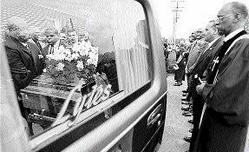
Virginia Tech shooting victim Erin Peterson's coffin is placed inside a hearse as the Rev. Dr. Eugene Johnson Pastor (right) watches following funerals at Mount Olive Baptist Church in Centreville, Virginia last week. - Reuters
BLACKSBURG, Virginia (AP):
Senior Kevin Sterne will see the scar on his thigh every time he pulls on his pants. Freshman Hilary Strollo will have to decide whether to bare her stomach in a swimsuit. And on the day someone slips a wedding band on her finger, junior Katelyn Carney will see the healed-up hole that a Virginia Tech gunman put in her left hand.
Most of the dead from the April 16 massacre on campus are buried, their families learning to live with loss.
Those who survived will have their own struggles, from physical scars to deep wounds of the psyche, trying to figure out how to stop the most dramatic event in their lives from overshadowing everything else that happens to them.
Anne Lynam Goddard, whose son Colin was shot three times during the attack on his French class, sees his trauma the way doctors see the shrapnel embedded in the tissue of his wounded leg: trying to remove it would cause more pain and might make matters worse, so it is best to leave it be.
A mother's hopes
"Your body forms a cocoon, so it will always be part of you, but it won't hurt. That's how I started thinking about this early on," she said. "My biggest hope is that this is how my son will remember this. I hope he can form a cocoon around it and not let it be his defining moment."
The terror of those moments is nightmarish. After sneaking into a dorm and killing two students with two shots from a 9-mm handgun, Seung-Hui Cho took his time, heading to a post office to mail a package of video and writings expressing his anger. Then he chained the doors of Norris Hall, stormed several classrooms and unloaded more than 170 rounds over nine long minutes. Students - some wounded, some not - cowered, played dead and listened in horror as 30 of their classmates and teachers died.
Cho then put a bullet through his head and dropped to the floor amid his victims.
Most of the 25 people hurt in the worst mass shooting in modern U.S. history are healing in private, declining or ignoring interview requests.
Justin Klein, a junior from Catonsville, Maryland, who survived three gunshot wounds, issued a statement saying he is progressing physically and emotionally. He is back on campus, with friends forming a buffer around his wheelchair, shielding him from reporters.
"My place is here, with my friends," Klein wrote. "The Hokie community is strong and resilient, we will persevere, we will go on and we will heal."
It will not be easy. As the weeks and months unfold, the wounded could experience depression, survivor's guilt, thoughts of suicide, anger, depression and post-traumatic stress disorder. Physical injuries and painful follow-up surgeries could slow students' academic progress and keep them feeling somewhat isolated, said Melissa Brymer, a clinical psychologist with the UCLA-Duke National Center for Child Traumatic Stress.
Peers' coping ability
"Their scars can be reminders to themselves and to others, so this may impact their peer relationships. Their peers might not be able to cope with those reminders. They might distance themselves," she said.
There is no single way for victims of a tragedy to recover and adapt to what has happened, said Mark Lerner, a clinical psychologist and traumatic stress consultant.
"For some people, getting back on the horse, getting back on the bicycle and exposing themselves to this difficult environment where this has occurred, being back on that campus will be a really good thing for them," Lerner said. "For others, it may be more than can be expected, too much for them to handle."
Patrick Strollo, brother of injured freshman Hilary Strollo, said there is no doubt she will return to campus after recovering at home in Gibsonia, Pennsylvania, from three gunshot wounds.
"What are the other options? She's not the only one who had something happen to her. Every single person who goes to that school has had something happen to them," he said. "She has a ton of friends there and she needs to stick to the people she can relate with, and they're going to get through this together."
Strollo faces a struggle similar to that of Sterne and Carney. Sterne was wounded in the leg, the image of him being carried out of the building captured in a now-famous photograph. Carney was hit in the hand during her German class, but helped fend off the gunman by barricading the door to stop him from getting back into the room.

